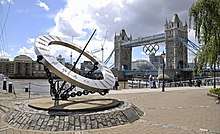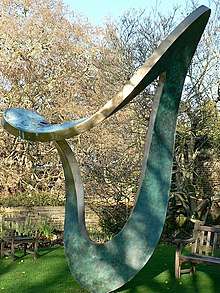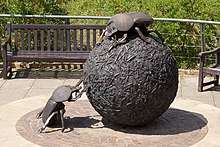Wendy Taylor
Wendy Ann Taylor CBE (born Stamford, Lincolnshire, 1945) is an English artist and sculptor, specialising in permanent, site-specific commissions.
Wendy Taylor | |
|---|---|
.jpg) Octo, Milton Keynes | |
| Education | St Martin's School of Art |
| Known for | Sculpture |
| Movement | Modernism |
| Website | http://wendytaylorsculpture.co.uk/ |
Early life and education
Wendy Taylor studied from 1963 to 1967 at the Saint Martin's School of Art in London. She gained renown for her many sculptures in the public realm, especially in London.
Career

Taylor's abstract sculptures explore themes of equilibrium, materiality and fabrication. From 1986 to 1988, she was design consultant for the Commission for New Towns. In 1988, Taylor was the subject of a documentary on The South Bank Show, and, in 1992, her work was profiled in a monograph by Edward Lucie-Smith.
In 1988, Taylor was appointed a Commander of the Order of the British Empire. In 1999, she restored the Virginia Quay Settlers Monument at Blackwall, London,[1] adding an astrolabe. In 2005, a major exhibition of her work was held at the Cass Sculpture Foundation in Goodwood titled The Seed Series. In 2009, this exhibition travelled to Canary Wharf in London.
Three of her works are Grade II listed structures: the Virginia Quay Settlers Monument,[2] Timepiece in St Katharine Docks, London,[3] and the Octo sculpture and reflecting pool,[4] in Milton Keynes.
Taylor lives and works in London.
Exhibitions
Works



- 1971: Triad, Somerville College, Oxford
- 1973: Timepiece, St Katharine Docks, London
- 1979/80: Octo, Norfolk House, Milton Keynes
- 1982: Essence, Saxon Court, Milton Keynes
- 1983: Gazebo, Golders Hill Park, London Barnet
- 1986: Pharos, East Kilbride South Lanarkshire
- 1987: Docklands Enterprise, West Dock/Marsh Lane
- 1987: Globe Sundial Sculpture, Marine Walk, Swansea
- 1994: Jester, Emmanuel College, Cambridge, and the Donald M. Kendall Sculpture Gardens, Purchase, USA
- 1997: Rope Circle, Hermitage Basin, London
- 1997: Spirit of Barrow
- 1999: Dung Beetles, Millennium Conservation Centre, Regent's Park, London
- 1999: Virginia Quay Settlers Monument, Jamestown Way, London (restoration of the 1928 monument)
- 2000: Tortoises with Triangle and Time, Holland Park, London
- 2000: The Millennium Fountain, River Walk, Enfield
- 2001: Voyager, Wapping High Street
- 2003: Knowledge, Library Square, Queen Mary and Westfield College, London
- 2006: Sycamore, sculpture garden at Cass Sculpture Foundation, Goodwood
References
- "First Settlers Monument". www.tower-bridge.org.uk. Retrieved 8 March 2017.
- Historic England. "Virginia Quay Settlers Monument (Grade II) (1442213)". National Heritage List for England. Retrieved 10 October 2018.
- Historic England. "Timepiece Sculpture (Grade II) (1391106)". National Heritage List for England. Retrieved 10 October 2018.
- Historic England. "Octo sculpture and reflecting pool (Grade II) (1432576)". National Heritage List for England. Retrieved 10 October 2018.
- Wolfram, Eddie. 'An earlier situation and current hard-edge trends', Arts Review, Vol. 18, Issue 3, 19 February 1966, p. 51.
- "British Council exhibition BRITISH PRINTMAKERS 1968–1970". Retrieved 30 May 2019.
- Burland, Cottie, 'Sculpture 66', Arts Review, Vol. 18, Issue 24, 10 December 1966, p. 554.
External links
| Wikimedia Commons has media related to Wendy Taylor (sculptor). |